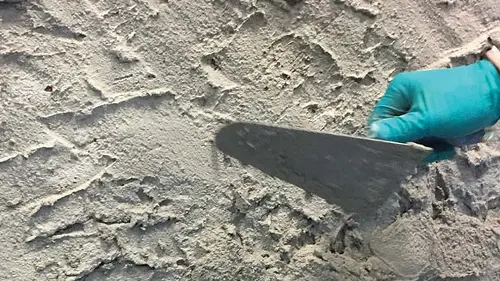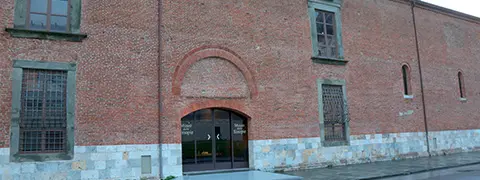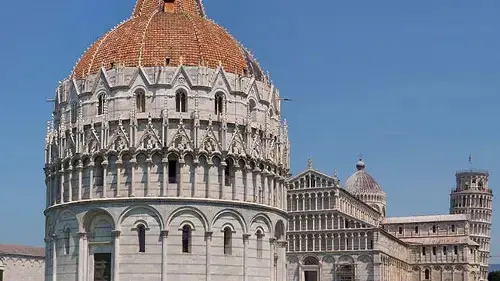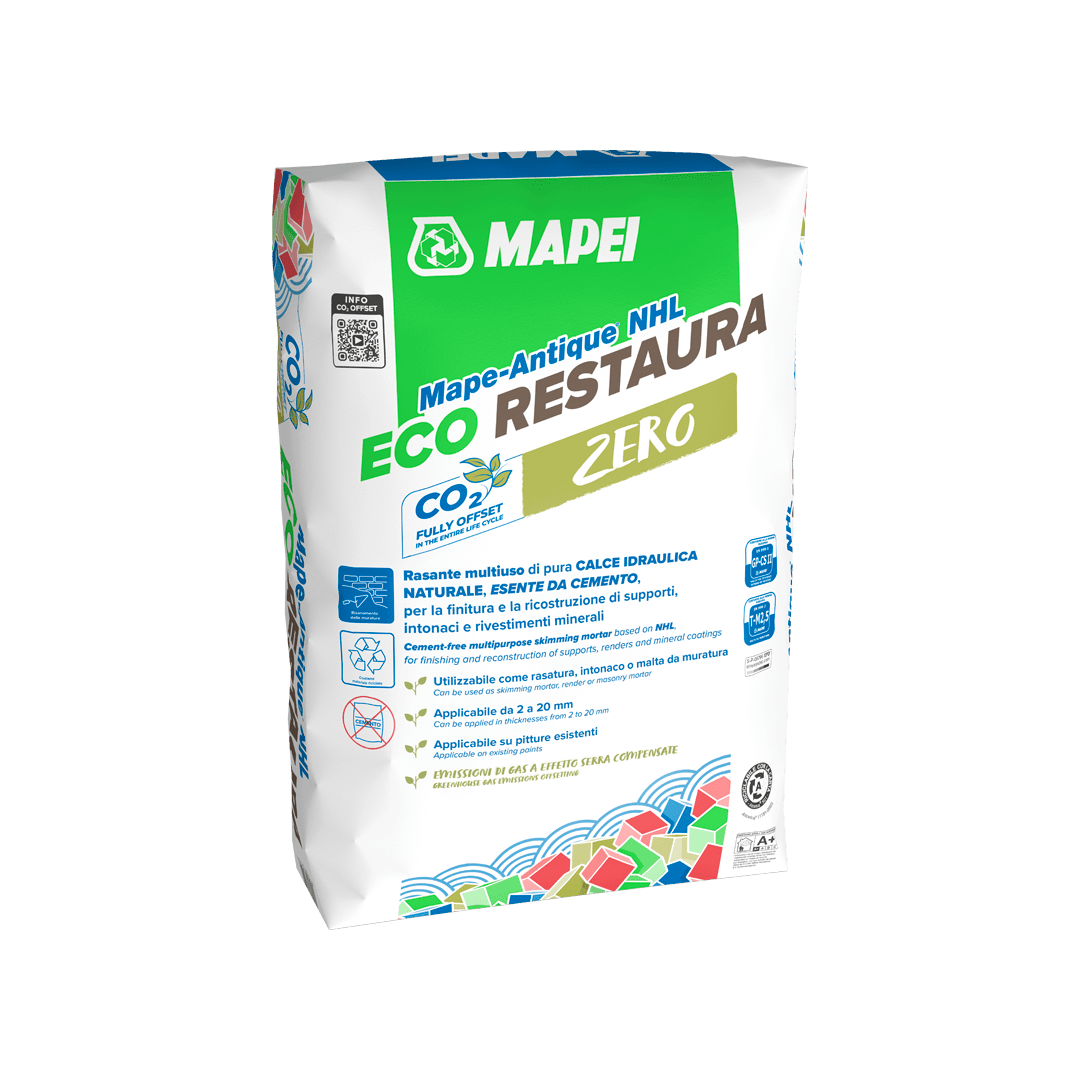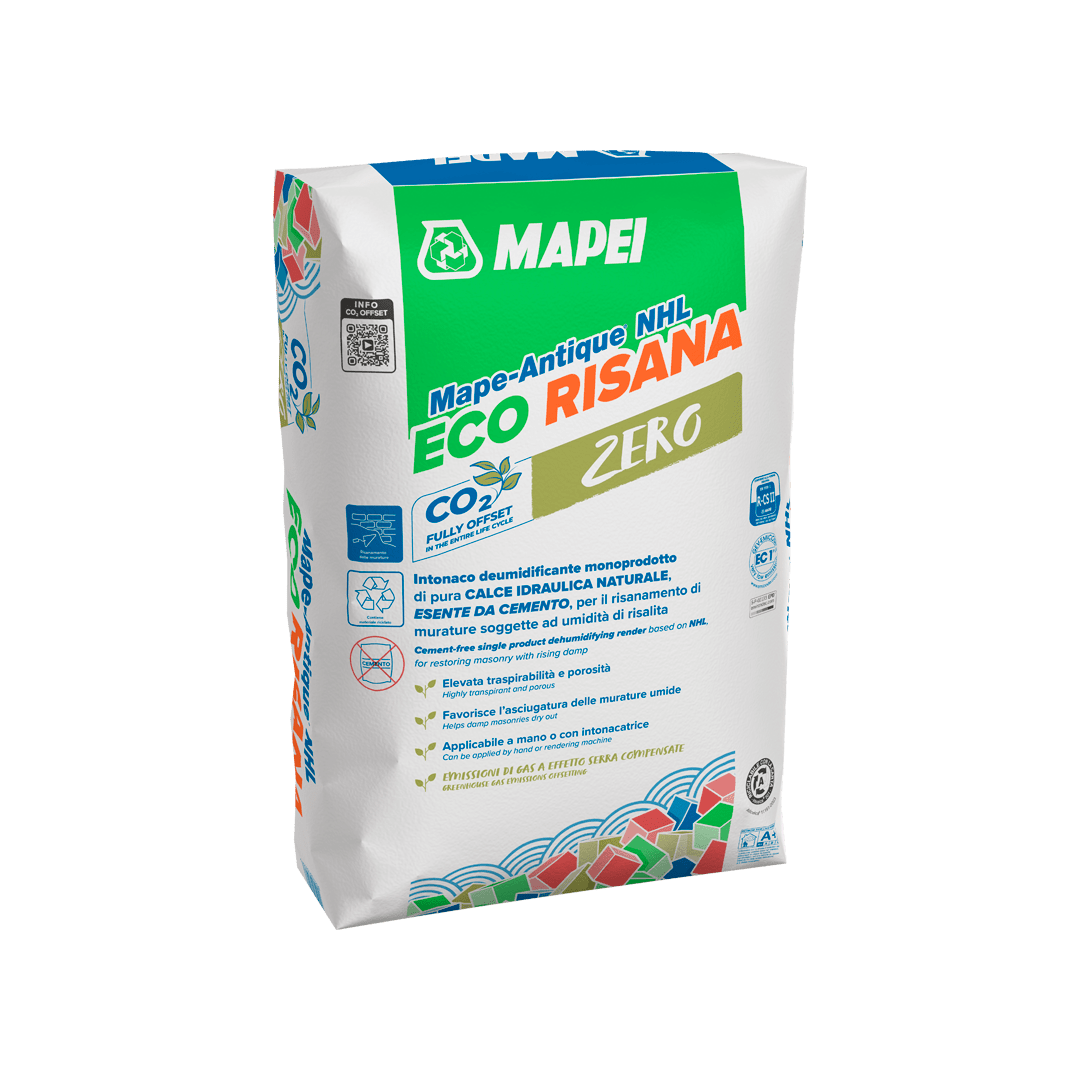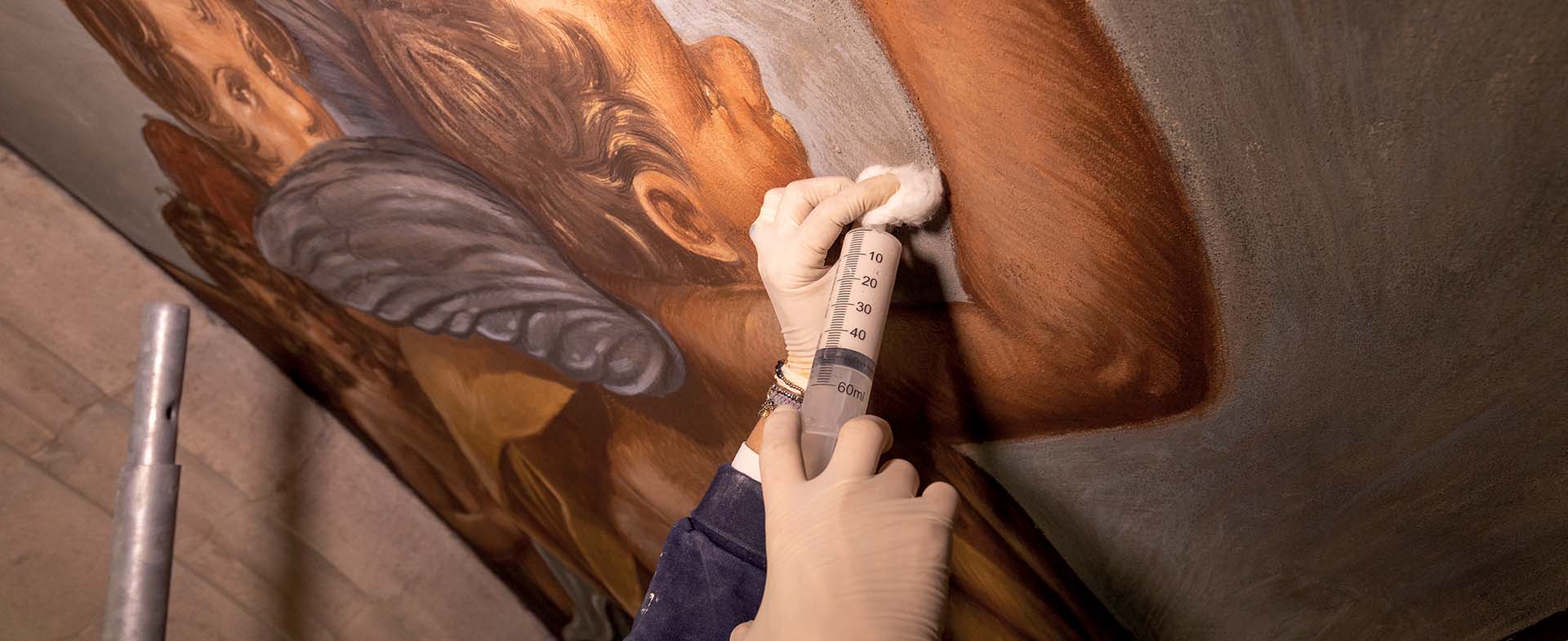
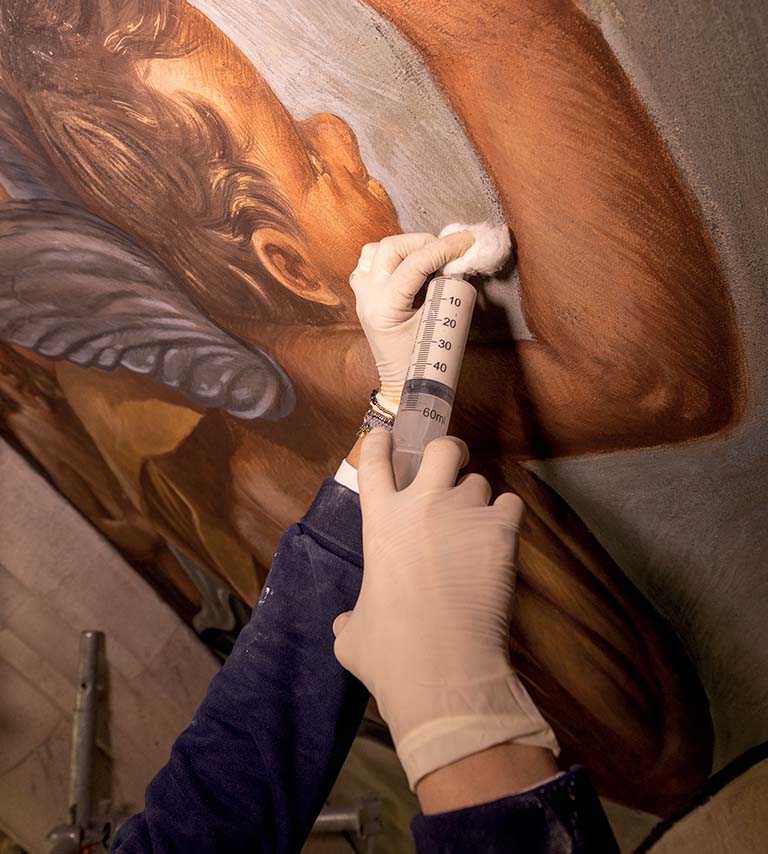
That mix of “old” materials, technology and sustainability
From Mapei, guidance to identify the most suitable products and systems for refurbishing and restoring historic buildings.
What are the main characteristics of the product line aimed specifically at masonry buildings and how has it evolved over the years?
In 1992 Mapei launched a product range called MAPE-ANTIQUE to offer specific solutions for interventions on ancient buildings, including those of artistic and architectural value.
These products are lime-based formulations with zero cement content and have similar chemical-physical and elastic-mechanical characteristics to masonry and rendering mortars used in the past.
Over the years this range has grown and has also evolved thanks to the experience gained on site while working on numerous historic buildings, both in Italy and abroad. Since the first products were launched in the 1990’s, many others have been added to the range to meet every specific need in the restoration field.
Today, this Mapei Line, called “Refurbishment and Restoration”, includes an extensive range of technologies and systems, some of which are specific for the refurbishment and restoration of quality buildings.
The aim of all this is to provide increasingly precise guidance to product specifiers/designers and applicators when selecting the most suitable technical solutions for their needs.
In 1992 Mapei launched the MAPE-ANTIQUE product range to offer specific solutions for ancient buildings, with zero cement content and similar chemical-physical and elastic-mechanical characteristics to materials used in the past.
What approach should be adopted when restoring a building of historical and architectonic significance?
The first fundamental phase is a “fact-finding” phase, which means accurately pinpointing what caused the deterioration or the current state of conservation of the structure by carrying out a thorough and complete visual analysis. The next phase is to carry out, if needed, a diagnostic analysis to determine, for instance, the composition of the original mortars, finishes, etc. In the third phase, the most suitable materials and the correct procedures for each phase of the work need to be identified based on the specific performance requirements. The most suitable product has to be chosen according to the actual problem that has emerged while, at the same time, making sure it is compatible with the characteristics of the substrate it will be applied on.
When carrying out the actual work, the final phase, but certainly no less important than the previous phases, is to define the application procedures and methods. These depend on the type of product chosen, which must be applied correctly by skilled personnel according to the recommendations supplied by the manufacturer.
Restoration work follows various principles such as reversibility, distinguishability, and a minimum intervention. And last but not least, compatibility. How can Mapei products help to solve these issues?
Safeguarding, conservation, appreciation and prevention are the key words that define the aim of a conservative restoration project on our historic and architectonic heritage. It is very important, however, to understand what they mean and their implications right at the very start of the development of a project so that, once all the work has been completed, it will last and, above all, will be shared by whoever takes charge of the monument to pass it on to future generations.
A small glossary of terms helps us get a better understanding of the sector we operate in and allows us to avoid confusion between different terms that are often used ambiguously or out of context. An example of this confusion is the difference between “restoration” and “refurbishment”. Restoration refers to any intervention carried out on monuments, architecture, works of art and other objects of artistic, historic or anthropological significance following their completion. The reasoning and purpose behind these interventions has varied quite significantly over the centuries from, on the one side, simply maintaining the efficiency of a monument, to modifying or upgrading a monument to suit contemporary tastes, on the other. A clear wish to conserve and preserve a monument can also coexist with the need to maintain a certain state or condition for future generations, such as in the case of restoration work on a fresco or façade, for example.
With “refurbishment”, on the other hand, we mean the resolution of one or more problems and the work carried out does not necessarily have to be conservative.
The term “reversibility” is usually used to identify a process that can be inverted and, as far as a product is concerned, it means it may be removed without causing any damage to a structure or to a construction element in general.
The term “compatible”, on the other hand, is associated with the properties of a product and identifies its chemical-physical and elastic-mechanical affinity with the characteristics of the original materials.
“Distinguishability” means the ability of those that admire a restored monument or feature to clearly distinguish between the restored part and the part that was not included in that particular restoration work.
Sustainability is one of the cornerstones of the Mapei philosophy. How is this principle applied and expressed within the refurbishment and restoration line?
Sustainability and environmental issues in general are a primary objective of the building process, thanks to the increasing level of awareness and sensitivity of public opinion, governments and all those involved in the process, from clients to designers and construction companies.
The use of materials with a high content of recycled materials, that have a low impact on the environment and very low emission of volatile organic compounds (VOC), manufactured in efficient production plants powered by renewable energy, are the at the heart of the journey Mapei has undertaken in the name of sustainability. Thanks to its Research and Development activities, Mapei combines the study of materials from the past and cutting-edge technology with all issues regarding sustainability, the aim being to supply materials of the highest quality that remain durable over time, and that have less impact on site thanks to more simple waste management procedures and a reduction in the amount of time and effort required to create product systems.
A concrete example of this journey are the products from the new MAPE-ANTIQUE NHL range, and especially MAPE-ANTIQUE NHL ECO RISANA and MAPE-ANTIQUE ECO RESTAURA (available from the 1st of April, 2022). The former is a one-component, cement-free, salt-resistant, dehumidifying eco-render made from pure natural hydraulic lime, which is particularly recommended for historic buildings, as well as for more recent builds.
The latter is a breathable, cement-free, pure natural hydraulic lime and Eco-Pozzolan mortar for restoring and levelling substrates and render.
Mapei systems have been applied during redevelopment work on both ancient and modern masonry buildings. What are the main differences?
There are no substantial differences between restoring an ancient masonry building and a more modern one. Once the causes of the problem or deterioration have been identified for one or the other type of building, Mapei’s strength lies in having such an extensive range of products available to help prescribers-designers and applicators identify the most suitable product for the refurbishment and conservative restoration of each type of building.
All this is the result of a constant commitment to Research & Development that, for Mapei, is one of the cornerstones of its strategy and routine approach to work. Research makes it increasingly necessary and important for us to involve a wide spectrum of people who have the ability to oversee every phase of the analysis and study of our historic and architectural heritage, to guarantee that a restoration project is executed correctly, from start to finish.
A concrete testimony of this virtuous synergy between all the stakeholders involved are the recent restoration works on the Baptistery in Piazza Dei Miracoli in Pisa and the Aquilonare Sacristy in Milan Cathedral and the Giorgio Gaber Theatre, also in Milan, which you can read more about on the next pages, as well as the Santa Maria Annunciata Church designed by Giò Ponti in Milan.







